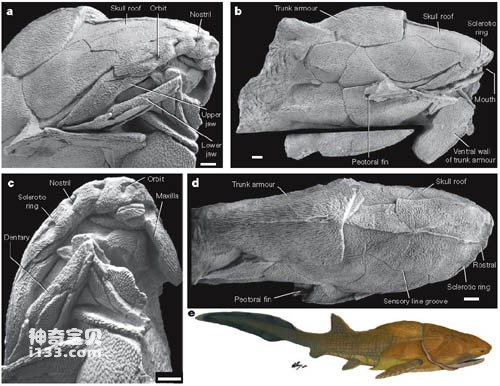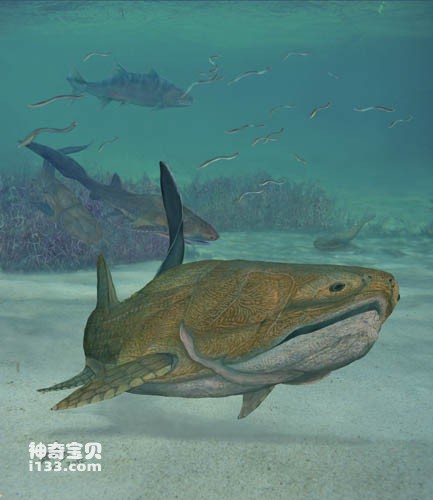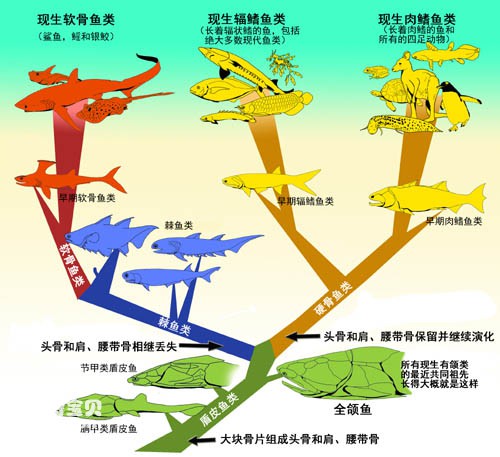On September 25, the British "Nature" magazine website published a paleoecological restoration picture on the homepage headline, and reported a report on ancient vertebrae from the Chinese Academy of Sciences under the title "Ancient fish show new face - jaw-dropping scientific discoveries" The latest research results of researcher Zhu Min from the Institute of Zoology and Paleoanthropology and his colleagues.
From an evolutionary perspective, humans are members of the teleost class. Human facial bones, such as the maxillary bones that make up our upper jaw, and the mandible bones (also called denticles) that make up our chin, were all present in early bony fishes. Prototypes can be found. However, paleontologists have not found definite evidence as to how these bones of bony fish, especially the upper and lower jaws, originated.

Figure 1 Fossil of Entelognathus primordialis, a front and side view, b side view, c front and ventral view, d dorsal view, c restoration picture.
In 2010, Zhu Min and others discovered a well-preserved ancient fish fossil in the ancient Silurian strata in Qujing, Yunnan, which had both the body characteristics of a placoderm and the jaw characteristics of a bony fish. After research, they named it "Initial Holognathus". The discovery fills a "missing link" in evolution and unravels the mystery of the origin of the jaw. Since Holognathus is the first time that human facial bones have appeared simultaneously on the stage of evolutionary history, scientists have colloquially called this discovery "the new face of ancient fish".
Vertebrates with upper jaws, that is, jaws, are called gnathostomes. The gnathostomes are divided into four major groups: placoderms, acanthus, cartilaginous fish, and bony fish. The jaws of placoderms, sticklebacks, and cartilaginous fishes are mostly made of cartilage. Only bony fish have a series of bony jaws on the edges of their mouths, forming a complex "new jaw" that is considered the prototype of the human jaw.

Figure 2 Ecological restoration map of the initial Holognathus primordialis
Holognathus lived in the shallow coastal sea on the northern edge of Gondwana 420 million years ago. When alive, its body length was about 20 centimeters. It not only has the typical "armor" of placoderms made of overlapping large bone fragments, but also has the hard jaws that grow on the edge of the mouth that were previously thought to be only found in bony fish. In other words, it has a bony fish mouth on the body of a placoderm. This strange combination of features provides an intermediate bridge between bony fishes and placoderms. Based on this, it is inferred that bony fish should have evolved directly from a branch of placoderms, and did not go through the stickleback stage as previously thought.

Figure 3 The discovery of holognathic fish changed the vertebrate evolutionary tree
Matt Friedman of the University of Oxford, UK, and Dr. Martin Blazer of Imperial College London wrote a review titled "Jaw-dropping Fossil Fish" and said, "We have always thought that the ancestors of jawed vertebrates were like modern sharks, but the new Fossils would completely overturn this view." They believe this discovery provides persuasive evidence for a close relationship between placoderms and bony fishes, thereby changing our understanding of the evolution of early jawed animals.
Professor John Lang, vice president of the Society of Vertebrate Paleontology, wrote: "For paleontologists, finding this fish is like physicists finding the Higgs boson (God particle). It has greatly impacted our understanding of early times. The understanding of vertebrate evolution ... is one of the most exciting fossil discoveries since Archaeopteryx, the first fossil to bridge the gap between dinosaurs and birds."
Source: Institute of Vertebrate Paleontology and Paleoanthropology, Chinese Academy of Sciences
animal tags:
We created this article in conjunction with AI technology, then made sure it was fact-checked and edited by a Animals Top editor.